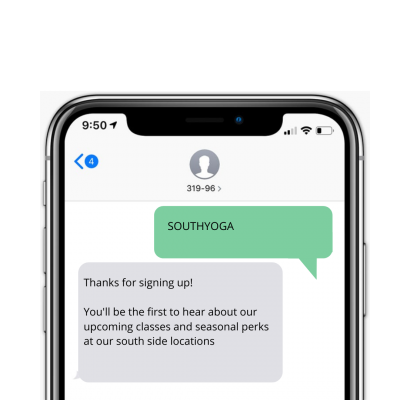How to Use Location Based Advertising With SMS (Examples Included)

Updated April 22, 2024
Location, location, location isn’t just a saying in real estate.
Businesses have long been searching for ways to segment their communications so that only people who are nearby receive their marketing. You’ve probably heard the buzzword: location-based advertising.
Not quite sure what location-based advertising is or how you’d make it work for you? Here’s everything you need to know about this savvy marketing technique, including simple strategies for implementing location-based advertising into your marketing mix right now — especially as it relates to mass texting.
How does location-based advertising work?
Location-based advertising (LBA) is a strategy for marketing that combines mobile ads with location tracking to show consumers content relevant to their physical location. For example, if you’re walking by a coffee shop, you might receive an ad on your phone with its daily specials. This would be location-based advertising at work.
Location-based advertising doesn’t have to be that direct. It can also involve sending ads based on a customer’s general geographic area, such as by zip code or area code. For example, if you run a business with multiple locations, you might want to only target customers with promotional texts who are near Location A with a certain promotion. Location-based advertising lets you do this.
Why use location-based advertising?
Simply put: A lot of people own smartphones. In fact, SMS statistics show 7.1 billion people worldwide are projected to use smartphones in 2024. Traditional advertising channels worked when people were glued to their T.V. or radios — nowadays, people are glued to their smartphones. You need to meet them where they are and serve valuable content. When location-based advertising is done right, it’s hyper-valuable because it’s deeply contextualized to a person’s unique experience.
Is location-based marketing effective?
Statistics show more than eight out of ten marketers (84%) are using location-based marketing in some way. The majority of these marketers (52%) are using location-based advertising to personalize their customer experience and create hyper-engaged audiences.
It’s predicted that marketers will spend up to $38.7 billion on location-based marketing in 2022. This is because it works.
MarTech data shows 83% of marketers feel their campaigns are more effective with location-based advertising. The same amount see higher response rates when they use location-based advertising. Also, 74% of marketers see an improved return on investment, and 70% see an increased lift.
With the third party cookie cull in 2024, marketers intend to increase their use of location-based marketing.
Strategies for location-based advertising with SMS
Location-based mobile advertising is most easily accomplished using text marketing and it’s surprisingly simple to set up. Here are four ways you can get started.
Example 1: Use your web sign-up form
If you’re using a web sign-up form to obtain consent, you can easily add fields to help segment your list by location, then market to those locations. These fields could be state, city, or even zip code. Not everyone uses a web form for consent, so this option won’t work all the time, but it’s very simple to create if a web form is part of your strategy.
After you’ve collected this information, it’s just a matter of segmenting your list based on location. You can choose to send marketing SMS messages to members of your text list who have a specific zip code or live in a certain city.
Example 2: Create a conversation in Workflows
Our Workflows feature allows ultra control over how niche you can get with your location-based advertising. It’s easy to create automated conversations that ask your customers questions. Our state-of-the-art platform can read customer sentiment and automatically funnel them into additional streams for you to further segment your audience by marketing locations, interests, and more.
For example, you could segment customers by where they work and where they live. While their zip code might provide valuable information about their location in the evenings or weekends, asking a question such as “Do you work downtown,” can help you send them relevant information during the work day.
Example 3: Use textwords
Think of textwords like keywords. They’re the word or phrase that people text in to join your text list. If you have more than one location for your business, you can consider creating location-specific text words. This would put people from each location on separate text lists.
For example, if you’re a yoga studio, you could tell customers on the south side of town to use one text word, like SOUTHYOGA, and you can tell customers on the north side of town to use another textword, such as NORTHYOGA. Repeat this for all of your locations. That way, customers who live nearby and are most likely to visit your studio will hear about deals or promotions specific to that studio, allowing you to market by location.

Example 4: Use area codes
Another option for segmenting your list for location-based mobile advertising is to separate your list based on their phone number area code. Theoretically, everyone with a certain area code should be living in the same general area.
While this technically works, it’s not the best way to do location-based advertising. In fact, it’s somewhat rudimentary and prone to a lot of errors. People often move without changing their phone numbers, which makes this strategy unreliable.
The best use case for area codes to do location-based advertising is if you have a scenario where your location is very large — perhaps the entire state, or an entire region. Again, it’s probably best to use other data to segment your list, but this could be a good starting point if you only have access to area codes.
Should you start location-based mobile advertising?
Location-based advertising is becoming increasingly popular. Statistics show that nine out of ten marketers believe location-based advertising grew their sales. The same study found 86% of marketers think location-based mobile advertising fueled growth in their customer base.
Customers are looking for a more personal experience. They want to block out the noise and only receive messaging that is hyper-relevant to them. That’s what location-based advertising can do. At the same time, there are some drawbacks. Follow best practices to make sure you’re using location-based advertising right.
Pros
- Relevant ads: You’re adding value to customers by showing them ads that matter or have great relevance to their immediate circumstances.
- Build customer engagement: You’re more likely to develop brand enthusiasts when you’re sending them information they can actually use in the moment.
- Increase sales: Location-based advertising done right can help you grow revenue.
- Easy to start: Using SMS to start location-based mobile advertising takes only minutes to set up.
- You can talk to anyone with a phone: Some versions of mobile ads can only be sent to smartphone users, but if you do location-based advertising via SMS you can access anyone with a mobile phone.
Cons
- Needs to be specific: If you don’t have the right information to start segmenting your list, you’ll need to begin collecting more data by asking questions and soliciting responses from your current text list.
- Ineffective data: If your data is outdated or simply not relevant to your business, then location-based advertising will have a diminished impact.
- Could feel uncomfortable: Some consumers are uncomfortable when they feel hyper-targeted.
Common location-based advertising questions
Still have lingering questions about location-based marketing? Great, we’ve got answers.
How do you do location-based advertising?
There are many different strategies for location-based advertising using both digital and physical methods to initiate marketing plans centered around a customer’s physical location. Usually, location-based advertising means taking specific consumer data and using that to send mobile messages or ads based on where a customer currently is.
How can advertisers use location data?
Advertisers can send consumers different messages based on where they are by using data from mobile phones or data that was previously provided.
How is location data used?
Location data helps marketers understand what ads might be relevant to a consumer, and at what time. It helps show consumers more valuable, actionable advertisements.
How do advertisers know my location?
Using your area code, the text word you sign up with, or by tracking information you’ve provided about your preferences, advertisers can determine your location.
Use SMS for Location-Based Advertising & Marketing
Ready to implement location-based advertising into your marketing strategy? Get started with a free trial, or reach out to our team to learn more.